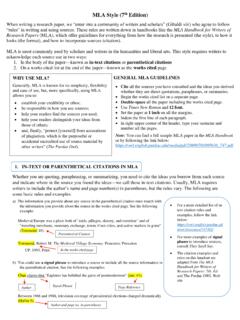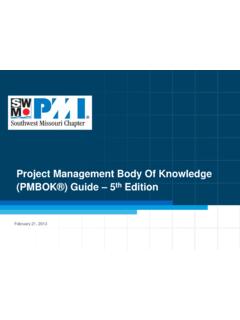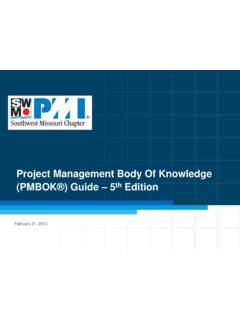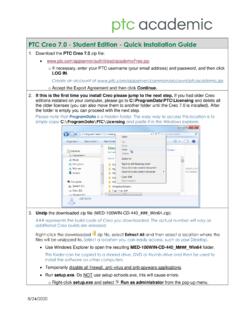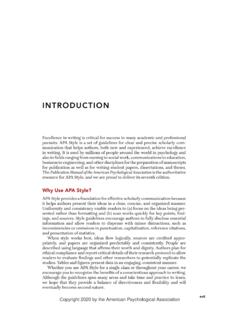Transcription of using the latest API 2000 7th edition guidelines
1 TANK STORAGE January/February 2015 81tank blanketingIn March 2014, API Standard 2000 (Venting Atmospheric and Low-Pressure Storage Tanks) was revised. This seventh edition is the latest update and this article looks at how the latest changes affect the sizing of tank blanketing regulators, including backpressure ones used for vapour recovery fundamentals remain unchanged: Liquid flow and thermal changeThe first thing to understand is what has not changed. Namely, the fundamentals that impact tank pressure remain intact. This means that liquid flow (or pump-in and pump-out) and changes to temperature still form the fundamentals to the sizing calculations.
2 API Standard 2000 5th, 6th, and 7th EditionsThe API Standard 2000 5th edition takes into account tank volume, liquid flow, and temperature change. It was written as a basis for the pressure control of hydrocarbons, and considered industrial tanks as well. It is this 5th edition that is probably in widest use today. In 2009, this was updated to the API Standard 2000 6th edition . Note that the 5th edition remained in the form of Appendix A, so it was not made obsolete per se. The additional factors of average storage temperature, vapour pressure, and latitude were added in the 6th edition , as an additional focus was placed on alcohols which have higher vapour pressures and can significantly increase the inflow year, minor changes were implemented and the latest guideline is now the 7th edition .
3 One of the changes has to do with a simplified calculation for volatile liquids. New Variables: C-Factor & Y-FactorBoth the API Standard 2000 6th and 7th editions include new variables in the calculations which depend on latitude. The key latitude categories are Below 42 Degrees , Between 42 and 58 Degrees and Above 58 Degrees . These latitude lines are where weather patterns will shift enough to cause meaningful differences in tank pressure. As shown in the tables, the C-Factor depends not only on latitude, but also on vapour pressure and average storage temperature. This C-Factor is used when making in-breathing flow Sizing tank blanketing regulators using the latest API 2000 7th edition guidelinesBasic Sizing Considera0ons Pump-In Pump-Out Vapor Space heats and expands Vapor Space cools and contracts Regulators must be sized to take into account tank pressure changes These changes include (1) liquid flow and (2) temperature change Basic sizing considerationsLiquid flow and thermal changeA comparison of recent standard updates API 2000 5th edition Tank volume Liquid flow (pump-in/-out)
4 Temperature change Directed at pressure control for hydrocarbons in low pressure tanks Industrial tanks as wellAPI 2000 6th edition (Appendix A = API 5th edition ) Tank volume Liquid flow (pump-in/-out) Pump out Temperature change Average storage temperature Vapour pressure Latitude Additional focus on alcohols Higher vapour pressures Can double the inflow (big change in thermal vacuum)API 2000 7th edition (Appendix A = API 5th edition ) Minor calculation changes For volatile liquids, the outbreathing calculation is simply doubled No need to perform an evaporation rate calculation82 January/February 2015 TANK STORAGE tank blanketingcalculations, which are required to size a tank blanketing regulator.
5 The Y-Factor, on the other hand, is only dependent on latitude and is used when making out-breathing calculations, which are required to size a vapour recovery regulator. Sizing calculation for a tank blanketing regulatorLet s now turn to the sizing calculations themselves, starting with in-breathing, which will determine the flow requirement for a tank blanketing regulator. The general steps are:(1) determine the volumetric flow rate required to replace the liquid being pumped out;(2) determine the volumetric flow rate required due to temperature drop;(3) add the results of (1) and (2) together. Tank blanketing regulator flow = maximum pump out rate + temperature drop= [ x maximum pump out rate] + [ x C-Factor x (Tank Volume) x insulation factor] (Note that the constants and are to convert the result from metric to English units.)
6 To illustrate how this calculation, consider the following example:Latitude Below 42 Degrees Vapour pressure UnknownAverage storage temp 80 FTank volume 50,000 barrelsInsulation NoneMax pump in/out 100 gallons/min VolatileTank blanketing regulator flow = maximum pump out rate + temperature drop= [ x maximum pump out rate] + [ x C-Factor x (Tank Volume) x insulation factor] = [ x 100] + [ x ( ) x (50,000 x ) x 1]= 131,254 SCFHNote that the insulation factor is 1 because there is no insulation. Also, the constant converts barrels to cubic feet so that a result in SCFH can be obtained. Implications of the new guideline: in-breathingThe latest API Standard 2000 7th edition (and 6th edition for that matter) result in greater in-breathing requirements, and they may be much greater depending on the C-Factor which takes into account vapour pressure, average storage pressure, and latitude.
7 This is illustrated in the graph below which shows in-breathing requirements versus tank size. The curve at the bottom of the graph depicts results using API Standard 2000 5th edition , also known as Appendix A. Note that this curve ends at 180,000 barrels. This is because the scope of this edition was limited to this tank size. All of the other curves depict the 7th edition , under different C-Factors. It can be seen that the relationship between in-breathing and tank size is not a linear one. The reason is that for smaller tanks, the tank surface to volume ratio is greater and for larger tanks, the surface to volume ratio is smaller.
8 This is why the curves start out linear and then tend to flatten out. The latitude variableC-Factor and Y-FactorAPI 6th & 7th Edi0ons New Variables Vapor pressure higher than Hexane or unknown< 77 F> 77 F< 77 F> 77 FBelow 42 42 and 58 Degrees3555 Above 58 pressue similar to HexaneC- FactorAverage Storage TemperatureLatitudeY- FactorBelow 42 42 & 58 58 Y- FactorBelow 42 Deg 42 & 58 Deg 58 Deg C-FactorLatitude Vapour pressure similar to Hexane Vapour pressure higher than Hexane or unknown Average storage temperature <77 F >77 F <77 F >77 FBelow 42 Deg 4 42 and 58
9 Deg 3 5 5 5 Above 58 Deg 4 4 4 API Standard 2000 5th versus 6th/7th editions in-breathingTANK STORAGE January/February 2015 83tank blanketingSizing calculation for a vapour recovery regulatorLet s now turn to the sizing calculations for out-breathing, which will determine the flow requirement for a vapour recovery regulator. The general steps in this case are:(1) determine the volumetric flow rate required to compensate for the liquid being pumped in;(2) determine the volumetric flow rate required due to temperature rise;(3) add the results of (1) and (2) together. In the case of the out-breathing calculations, there are two sets of equations, one for non-volatile, and another for volatile liquids Vapour recovery regulator flow = maximum pump in rate + temperature rise = [ x maximum pump in rate] + [ x Y-Factor x (Tank Volume x ) x Insulation Factor] (Note that the constants and are to convert the result from metric to English units.)
10 Volatile liquidsVapour recovery regulator flow = maximum pump in rate + temperature rise = [ x maximum pump in rate] + [ x Y-Factor x (Tank Volume x ) x Insulation Factor] The only difference between the equations for non-volatile and volatile liquids is that the constant changes to for volatile liquids. This is a key simplification mentioned earlier, that has been implemented with the 7th edition of API Standard 2000. Volatile liquids will result in twice the out-breathing flow requirements as non-volatile ones. To illustrate how this calculation works, consider the same example once again:Latitude Below 42 Degrees Vapour pressure UnknownAverage storage temp 80 FTank volume 50,000 barrelsInsulation NoneMax pump in/out 100 Gallons/minLiquid type VolatileVapour recovery regulator flow = maximum pump in rate + temperature rise= [ x maximum pump in rate] + [ x Y-Factor x (tank volume x ) x Insulation factor] = [ x 100] + [ x x (50,000 x ) x 1]= 40,314 SCFHI mplications of the new guideline: out-breathingThe graph above shows a comparison of out-breathing requirements versus tank size.













